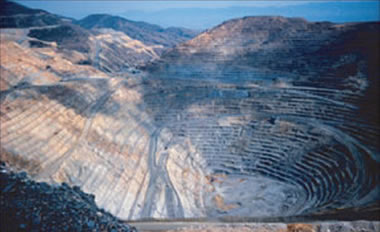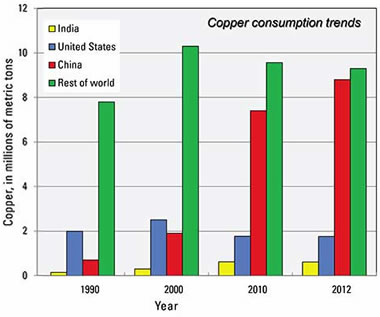Facts About Copper Copper Uses, Resources,
Post# of 4018

Facts About Copper
Copper Uses, Resources, Supply, Demand and Production Information
Republished from a USGS Fact Sheet from June, 2009
Copper - A Metal Used Through The AgesCopper was one of the first metals ever extracted and used by humans, and it has made vital contributions to sustaining and improving society since the dawn of civilization. Copper was first used in coins and ornaments starting about 8000 B.C., and at about 5500 B.C., copper tools helped civilization emerge from the Stone Age. The discovery that copper alloyed with tin produces bronze marked the beginning of the Bronze Age at about 3000 B.C. Copper is easily stretched, molded, and shaped; is resistant to corrosion; and conducts heat and electricity efficiently. As a result, copper was important to early humans and continues to be a material of choice for a variety of domestic, industrial, and high-technology applications today. How Do We Use Copper Today?Presently, copper is used in building construction, power generation and transmission, electronic product manufacturing, and the production of industrial machinery and transportation vehicles. Copper wiring and plumbing are integral to the appliances, heating and cooling systems, and telecommunications links used every day in homes and businesses. Copper is an essential component in the motors, wiring, radiators, connectors, brakes, and bearings used in cars and trucks. The average car contains 1.5 kilometers (0.9 mile) of copper wire, and the total amount of copper ranges from 20 kilograms (44 pounds) in small cars to 45 kilograms (99 pounds) in luxury and hybrid vehicles. Ancient Uses of CopperAs in ancient times, copper remains a component of coinage used in many countries, but many new uses have been identified. One of copper's more recent applications includes its use in frequently touched surfaces (such as brass doorknobs), where copper's antimicrobial properties reduce the transfer of germs and disease. Semiconductor manufacturers have also begun using copper for circuitry in silicon chips, which enables microprocessors to operate faster and use less energy. Copper rotors have also recently been found to increase the efficiency of electric motors, which are a major consumer of electric power. What Properties Make Copper Useful?
The excellent alloying properties of copper have made it invaluable when combined with other metals, such as zinc (to form brass), tin (to form bronze), or nickel. These alloys have desirable characteristics and, depending on their composition, are developed for highly specialized applications. For example, copper-nickel alloy is applied to the hulls of ships because it does not corrode in seawater and reduces the adhesion of marine life, such as barnacles, thereby reducing drag and increasing fuel efficiency. Brass is more malleable and has better acoustic properties than pure copper or zinc; consequently, it is used in a variety of musical instruments, including trumpets, trombones, bells, and cymbals. Types of Copper DepositsCopper occurs in many forms, but the circumstances that control how, when, and where it is deposited are highly variable. As a result, copper occurs in many different minerals. Chalcopyrite is the most abundant and economically significant of the copper minerals. Research designed to better understand the geologic processes that produce mineral deposits, including copper deposits, is an important component of the USGS Mineral Resources Program. Copper deposits are broadly classified on the basis of how the deposits formed. Porphyry copper deposits, which are associated with igneous intrusions, yield about two-thirds of the world's copper and are therefore the world's most important type of copper deposit. Large copper deposits of this type are found in mountainous regions of western North and South America. Another important type of copper deposit-the type contained in sedimentary rocks-accounts for approximately one-fourth of the world's identified copper resources. These deposits occur in such areas as the central African copper belt and the Zechstein basin of Eastern Europe.
Individual copper deposits may contain hundreds of millions of tons of copper-bearing rock and commonly are developed by using open-pit mining methods. Mining operations, which usually follow ore discovery by many years, often last for decades. Although many historic mining operations were not required to conduct their mining activities in ways that would reduce their impact on the environment, current Federal and State regulations do require that mining operations use environmentally sound practices to minimize the effects of mineral development on human and ecosystem health. USGS mineral environmental research helps characterize the natural and human interactions between copper deposits and the surrounding aquatic and terrestrial ecosystems. Research helps define the natural baseline conditions before mining begins and after mine closure. USGS scientists are investigating climatic, geologic, and hydrologic variables to better understand the resource-environment interactions. Copper Supply, Demand and RecyclingThe world's production (supply) and consumption (demand) of copper have increased dramatically in the past 25 years. As large developing countries have entered the global market, demand for mineral commodities, including copper, has increased. In the past 20 years, the Andean region of South America has emerged as the world's most productive copper region. In 2007, about 45 percent of the world's copper was produced from the Andes Mountains; the United States produced 8 percent. Virtually all copper produced in the United States comes from, in decreasing order of production, Arizona, Utah, New Mexico, Nevada, or Montana. The risk of disruption to the global copper supply is considered to be low because copper production is globally dispersed and is not limited to a single country or region. Because of its importance in construction and power transmission, however, the impact of any copper supply disruption would be high. Copper is one of the most widely recycled of all metals; approximately one-third of all copper consumed worldwide is recycled. Recycled copper and its alloys can be remelted and used directly or further reprocessed to refined copper without losing any of the metal's chemical or physical properties. How Do We Ensure Adequate Supplies of Copper for the Future?To help predict where future copper resources might be located, USGS scientists study how and where known copper resources are concentrated in the Earth's crust and use that knowledge to assess the potential for undiscovered copper resources. Techniques to assess mineral resource potential have been developed and refined by the USGS to support the stewardship of Federal lands and to better evaluate mineral resource availability in a global context. In the 1990s, the USGS conducted an assessment of U.S. copper resources and concluded that nearly as much copper remained to be found as had already been discovered. Specifically, the USGS found that about 350 million tons of copper had been discovered and estimated that about 290 million tons of copper remained undiscovered in the United States. Global Copper Resource AssessmentBuilding on the success of the U.S. national mineral resource assessment, the USGS has undertaken a global copper resource assessment in collaboration with international partners. An assessment of undiscovered porphyry copper resources in the Andes Mountains of South America was recently released; the authors conclude that more copper remains to be found there than has already been discovered. Specifically, about 590 million tons of copper has been discovered and about 750 million tons of copper is estimated to remain as undiscovered porphyry copper deposits. Mineral resource assessments are dynamic. Because they provide a snapshot that reflects our best understanding of how and where ore is located, the assessments must be updated periodically as better data and concepts are developed. Current research by the USGS involves updating mineral deposit models and mineral environmental models for copper and other important nonfuel commodities and improving the techniques used to assess for concealed mineral resource potential. The results of this research will provide new information to decrease uncertainty in future mineral resource assessments. | | 



|
 (0)
(0) (0)
(0)